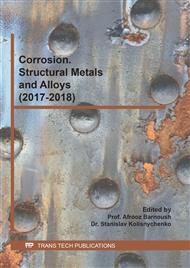p.1692
p.1698
p.1705
p.1710
p.1716
p.1722
p.1728
p.1734
p.1743
An Experimental Method to Evaluate the Effect of Welding Residual Stress on Corrosion Fatigue Properties of Structural Steel in Synthetic Seawater
Abstract:
Tensile residual stress can cause a reduction in the fatigue strength of steel not only in air but also in corrosive environments. In air, for example, the effect of residual stress on fatigue strength can be estimated by using relations between fatigue strength and mean stress such as the modified Goodman diagram. However, it is not clear whether a sort of fatigue strength estimation can be applicable to corrosion fatigue properties. This paper presents an experimental method to evaluate the effect of welding residual stress on corrosion fatigue properties quantitatively, where corrosion fatigue tests were conducted in synthetic seawater by using characteristic fatigue specimens that have two parts, a tensile residual stress part and the other supporting part. Bead-on-plate welding was performed for applying welding residual stress in the tensile residual stress part. Residual stress relaxation was measured using the X-ray diffraction method in the midst of fatigue testing. Effects of tensile residual stress on corrosion pit growth and S-N curves were discussed.
Info:
Periodical:
Pages:
1716-1721
Citation:
Online since:
December 2018
Authors:
Keywords:
Price:
Сopyright:
© 2018 Trans Tech Publications Ltd. All Rights Reserved
Share:
Citation:



